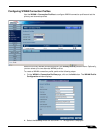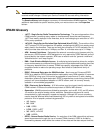
WWAN
387
SonicOS Enhanced 4.0 Administrator Guide
GPRS has an additional advantage over GSM in that it is a packet-switched technology,
meaning that stations only send data when there is data to send (rather than reserving the
entire channel as occurs in GSM's circuit-switched networks) thus making more efficient
use of available bandwidth. The process of connecting to a GPRS network generally
involves attachment to the network, followed by the construction and activation of a PDP
context, as performed by a series of AT commands. This process is largely automated by
SonicOS through the use of profiles, but also allows for manual PDP context construction.
• GSM - Global System for Mobile Communication - TDMA based protocol that uses
digital channels for both signaling and speech, making it a well suited platform for data
communications, although at very low data rates. GSM competes as a protocol with
Qualcomm's CDMA, but remains the most popular worldwide protocol. GSM
implementations are often regarded as less susceptible to signal degradation indoors.
Although GSM is used both in the Americas and the rest of the world, the American
implementation operates on a different frequency, and interoperability is not guaranteed
unless explicitly supported by the equipment.
• HSDPA - High Speed Downlink Packet Access - An evolution of UMTS (and thus of
GSM) based on W-CDMA technology. HSDPA can achieve very high data rates, with
subsequent phases targeting rates of up to 50 Mbps, but it is not currently very widely
adopted despite announcements of future support from many operators.
• IMEI - International Mobile Equipment Identity - A unique 15 digit number assigned to
every GSM/UMTS device for the purposes of identifying the device (not the subscriber) on
the network. The subscriber on these networks is identified by the IMSI number, which is
stored on the SIM card.
• IMSI - International Mobile Subscriber Identity - A unique 15 (or 14) digit number that
identifies subscribers on GSM/UMTS networks. The IMSI is stored on the subscriber's SIM,
and comprises a country code (as defined by ITU E.212), a network code (the network
operator), and a unique subscriber number.
• PDP Context - Packet Data Protocol Context - A data structure representing the logical
association of a station on a GPRS network. The data structure comprises a CID (context
identifier), a PDP_Type (the protocol being used, e.g. IP), an APN (Access Point Name),
and optional a PDP_Addr (PDP Address) to identify the usable address space for the
connection. After a PDP Context is constructed, it must be activated.
• SIM - Subscriber Identity Module - USIM (Universal SIM) in UMTS. A SIM, also known as
a Smart Card, stores unique subscriber information, including subscription and service
parameters as well as preferences and settings. SIMs are used by all GSM devices, and
allow for a subscriber's identity to move from one GSM device to another. Many operators
lock their devices to prevent the use of other operator's SIM cards, but operators will
sometimes unlock their devices if certain conditions are met.
• TDMA - Time Division Multiple Access - TDMA is used by most currently available GSM
networks. It allows multiple concurrent access to a frequency by dividing it into time-slots,
where each station takes turns transmitting. Since TDMA based technologies switch their
transmitters on and off rapidly (native TDMA switches at 50 Hz, GSM switches at 217 Hz),
radio frequency (RF) pollution is created. When the power output is high enough (such as
right before a call is received), these RF signals (particularly GSM's 217 Hz signal, which
is in the audible spectrum, even on really cheap computer speakers) can be picked up by
nearby amplification circuitry, producing a buzzing sound. So don't put your GSM equipped
TZ 190 on top of a stereo, and don't balance it on your head if you wear hearing aids.
• UMTS - Universal Mobile Telecommunication System - Employing W-CDMA
technology, UMTS is considered the evolution of GSM, and is sometimes referred to a
3GSM. UMTS is in fairly wide deployment worldwide, with the exception of the Americas,
where EDGE is favored, and where UMTS will likely be leapfrogged as GSM's successor
by HSDPA.


















